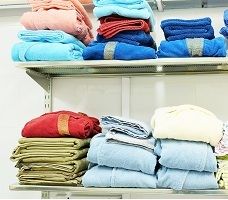Article
Hospital Laundry Facilities Could Be Source of C. difficile Transmission
Author(s):
Researchers tested hundreds of surface samples from a clinical laundry facility and found multiple strains of C. difficile, mainly in the areas that handled soiled clinical linens.

Dirty laundry from clinical settings — especially those that have been soiled – may be a source for Clostridium difficile surface contamination, according to findings published in FEMS Microbiology Letters.
Researchers from the University of Washington in Seattle took 240 surface samples from 120 dirty laundry areas in order to determine if C. difficile could be cultured from clinical laundry facility surfaces. Half of the samples were taken from the area of the laundry that handled the soiled clinical linens, while the other half of the samples were collected from the area where clean linens are folded. The samples were collected four times throughout the 2015 year at the University of Washington Consolidated Laundry facility, which services several Seattle area hospitals.
The dirty laundry area was significantly more contaminated than the clean area, at rates of 21 percent to 2 percent, respectively, the researchers observed. The C. difficile bacteria isolates were genetically characterized by the investigators, who used multilocus sequence typing and polymerase chain reaction (PCR) for the detection of genes encoding toxin A and toxin B. They discovered MLST types 1, 2, 3, 15, 26, 34, 35, 39, 42, 43, 44, 53, 63 and 284, which had been previously found in both clinical and community settings, according to studies published previously, the researchers said. The investigators found toxin positive isolates in both the dirty and clean areas, though seasonal variation was observed as well: 40 percent of the 27 isolates cultured in April 2015.
The researchers claimed their study demonstrates that soiled clinical linens may be a source for C. difficile surface contamination.
"This research supports the idea that its possible for the soiled hospital linens to contaminate the environment with C. difficile, which is the number one cause of hospital associated diarrhea," study author Marilyn Roberts, PhD, said in an interview. "It's also extremely hard to remove from the environment. Due to this contamination, laundry facilities should be considered an extension of the healthcare environment when considering infection prevention and occupational health."
Related Coverage:
Consumer Reports Compiles List of Hospitals by Rates of C. difficile Infection
Hospital Bed CDI Transmission: Does Prior Occupant's Antibiotic Use Increase Risk?
Latest News and Updates on C. Difficile Infection Management and Treatment





